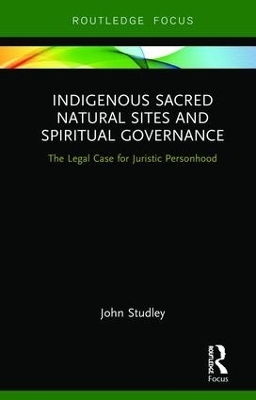
Indigenous Sacred Natural Sites and Spiritual Governance
The Legal Case for Juristic Personhood
Seiten
2018
Routledge (Verlag)
978-1-138-31623-2 (ISBN)
Routledge (Verlag)
978-1-138-31623-2 (ISBN)
This book examines the indigenous literature and recent legal cases as the basis for granting juristic personhood to enspirited sacred natural sites.
Since time immemorial indigenous people have engaged in legal relationships with other-than-human-persons. These relationships are exemplified in enspirited sacred natural sites, which are owned and governed by numina spirits that can potentially place legal demands on humankind in return for protection and blessing. Although conservationists recognise the biodiverse significance of most sacred natural sites, the role of spiritual agency by other-than-human-persons is not well understood. Consequently, sacred natural sites typically lack legal status and IUCN-designated protection. More recent ecocentric and posthuman worldviews and polycentric legal frameworks have allowed courts and legislatures to grant 'rights' to nature and 'juristic personhood' and standing to biophysical entities. This book examines the indigenous literature and recent legal cases as a pretext for granting juristic personhood to enspirited sacred natural sites.
The author draws on two decades of his research among Tibetans in Kham (southwest China), to provide a detailed case study. It is argued that juristic personhood is contingent upon the presence and agency of a resident numina and that recognition should be given to their role in spiritual governance over their jurisdiction. The book concludes by recommending that advocacy organisations help indigenous people with test cases to secure standing for threatened sacred natural sites (SNS) and calls upon IUCN, UNESCO (MAB and WHS), ASEAN Heritage and EuroNatura to retrospectively re-designate their properties, reserves, parks and initiatives so that SNS and spiritual governance are fully recognised and embraced.
It will be of great interest to advanced students and researchers in environmental law, nature conservation, religion and anthropology.
Since time immemorial indigenous people have engaged in legal relationships with other-than-human-persons. These relationships are exemplified in enspirited sacred natural sites, which are owned and governed by numina spirits that can potentially place legal demands on humankind in return for protection and blessing. Although conservationists recognise the biodiverse significance of most sacred natural sites, the role of spiritual agency by other-than-human-persons is not well understood. Consequently, sacred natural sites typically lack legal status and IUCN-designated protection. More recent ecocentric and posthuman worldviews and polycentric legal frameworks have allowed courts and legislatures to grant 'rights' to nature and 'juristic personhood' and standing to biophysical entities. This book examines the indigenous literature and recent legal cases as a pretext for granting juristic personhood to enspirited sacred natural sites.
The author draws on two decades of his research among Tibetans in Kham (southwest China), to provide a detailed case study. It is argued that juristic personhood is contingent upon the presence and agency of a resident numina and that recognition should be given to their role in spiritual governance over their jurisdiction. The book concludes by recommending that advocacy organisations help indigenous people with test cases to secure standing for threatened sacred natural sites (SNS) and calls upon IUCN, UNESCO (MAB and WHS), ASEAN Heritage and EuroNatura to retrospectively re-designate their properties, reserves, parks and initiatives so that SNS and spiritual governance are fully recognised and embraced.
It will be of great interest to advanced students and researchers in environmental law, nature conservation, religion and anthropology.
John Studley is an Independent Ethno-forestry Researcher and consultant, with many years of experience in the UK, China and Nepal.
1. INDIGENOUS SACRED NATURAL SITES WITH REFERENCE TO TIBET 2. THEORETICAL BASIS FOR POST-ANTHROPOCENTRIC APPROACHES TO NATURE AND JURISPRUDENCE 3. INDIGENOUS SPIRITUAL ECOLOGY 4. LEGAL BACKGROUND TO JURISTIC PERSONHOOD 5. LEGISLATIVE CHRONOLOGY OF CASES 6. LITIGATION TO DATE 7. CASE STUDY: RITUAL PROTECTION OF SNS IN THE TIBETAN REGION OF KHAM (SOUTHWEST CHINA) 8. THE CHALLENGE OF PERPETUATING SNS 9. HOW CAN SACRED NATURAL SITES BEST BE PROSECUTED?
| Erscheinungsdatum | 02.11.2018 |
|---|---|
| Reihe/Serie | Routledge Focus on Environment and Sustainability |
| Zusatzinfo | 6 Tables, black and white; 10 Line drawings, black and white; 20 Halftones, black and white; 30 Illustrations, black and white |
| Verlagsort | London |
| Sprache | englisch |
| Maße | 138 x 216 mm |
| Gewicht | 272 g |
| Themenwelt | Geisteswissenschaften ► Religion / Theologie ► Weitere Religionen |
| Recht / Steuern ► EU / Internationales Recht | |
| Recht / Steuern ► Öffentliches Recht ► Umweltrecht | |
| Sozialwissenschaften ► Ethnologie | |
| Sozialwissenschaften ► Soziologie | |
| ISBN-10 | 1-138-31623-7 / 1138316237 |
| ISBN-13 | 978-1-138-31623-2 / 9781138316232 |
| Zustand | Neuware |
| Haben Sie eine Frage zum Produkt? |
Mehr entdecken
aus dem Bereich
aus dem Bereich
archäologische Fakten und Fiktionen im Neuheidentum
Buch | Softcover (2023)
Verlag Anton Pustet
CHF 36,90


